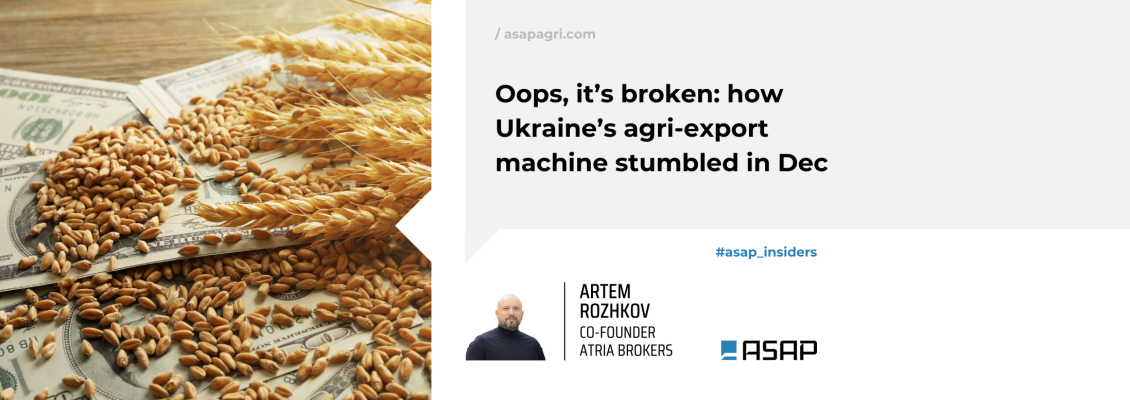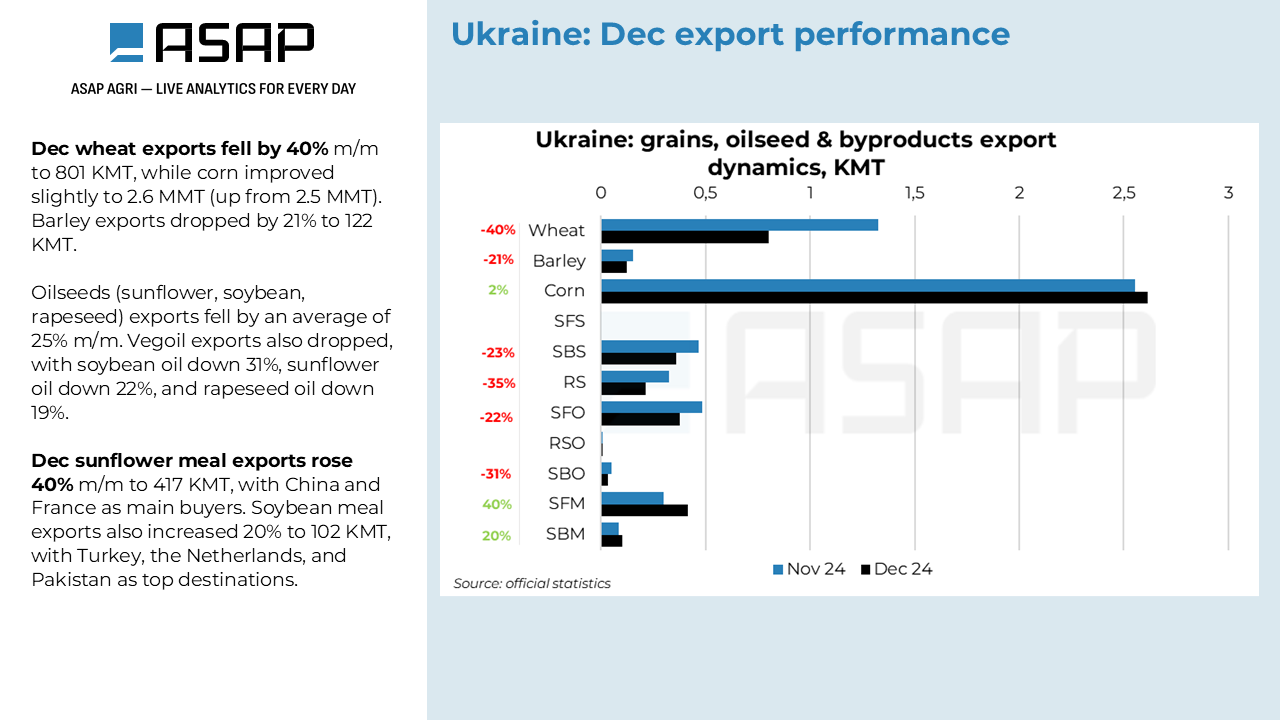
Артем Рожков, співзасновник Atria Brokers
Грудень мав стати ще одним місяцем високих результатів для
української агроекспортної машини — системи, відомої своєю здатністю годувати
світ. Натомість він перетворився на історію про збої, вузькі місця та жорстку
реальність. Зерно, олійні культури, продукти переробки — ніщо не уникнуло бурі.
Давайте відкинемо зайві слова й перейдемо до суті.
Цифри не брешуть
Станом на кінець грудня загальний аграрний експорт України ледве
перевищив 5,05 млн тонн. Це на 12% менше порівняно з 5,75 млн тонн у листопаді.
Так, ситуація виглядала гірше на початку місяця, і деяке відновлення згладило
удар, але не будемо прикрашати — це все одно втрата.
Кукурудза стала єдиним "бійцем" у категорії зернових,
показавши невелике, але важливе зростання. Експорт кукурудзи в грудні зріс до
2,6 млн тонн, порівняно з 2,5 млн тонн у листопаді. Але на цьому гарні новини
закінчуються. Пшениця? Вона не просто спіткнулась — вона впала. Експорт пшениці
скоротився на 40% на місяць, з 1,3 млн тонн у листопаді до лише 801 тис. тонн.
Ячмінь також зазнав втрат, впавши на 21%, з 155 тис. тонн до 122 тис. тонн.
Цифри не брешуть — це був важкий період для зернових.
Не кращою була ситуація в сегменті олійних культур та рослинних
олій, які зазнали сильного удару. Експорт соняшникового насіння, сої та ріпаку
скоротився в середньому на 25% порівняно з листопадом. Експорт рослинних олій
також виглядав похмуро. Експорт соєвої олії зазнав найбільшого падіння,
знизившись на 31% на місяць, тоді як експорт соняшникової та ріпакової олії
впав на 22% та 19% відповідно.
Але ось цікаве: не все пішло на спад. Експорт соняшникового шроту
різко зріс на 40%, до 417 тис. тонн, де Китай і Франція стали провідними
покупцями. Експорт соєвого шроту також показав несподіване зростання,
піднявшись на 20% на місяць, до 102 тис. тонн, із Туреччиною, Нідерландами та
Пакистаном серед основних покупців. Однак не варто себе обманювати — ці досягнення
схожі на спробу заклеїти потопаючий корабель скотчем. Вони помітні, але не
компенсують загальний колапс.
Що пішло не так?
Грудневі труднощі — це не просто невдача. Це наслідок ідеального
шторму хаосу.
Нові експортні регуляції перетворилися на бюрократичний жах,
затримуючи затвердження документів і зупиняючи поставки в невизначеності. Потім
відбулася логістична криза. Залізничні поставки до портів Великої Одеси —
критичних для експорту — зазнали значного скорочення. Чому? Перевантажені
термінали, масштабні відключення електроенергії та паралізовані енергетичною
кризою електровози. Так, дизельні локомотиви намагались компенсувати ситуацію,
але це був радше тимчасовий захід, ніж справжнє рішення.
І, звичайно, тут є дикий фактор: фермери. Багато виробників
вирішили утримати своє зерно в очікуванні вищих цін, в той час як система
надломлювалась під вагою їхнього рішення.
Що все це означає?
Це падіння експорту на 12% у грудні може не здаватися
катастрофічним, але це тривожний дзвінок. Він натякає на глибші проблеми в
системі — тиск нових регуляцій, розбиту логістичну мережу та ринок, який все ще
намагається стабілізуватися. Хоча зростання експорту соняшникового шроту та
соєвого шроту є обнадійливим, це радше локальні перемоги, ніж кардинальні
зміни.
Правда в тому, що українська агроекспортна машина отримала удар,
але далеко не вибула з гри. Головне питання зараз — як швидко система зможе
адаптуватися, відновитися та перебудуватися.
З початком 2025 року стає очевидним одне: українська агроекспортна
система має достатньо стійкості для відновлення, але їй потрібно рішуче
протистояти своїм викликам, якщо вона хоче повернути свій статус глобального
лідера.
Ніякої зайвої мішури. Ніякого прикрашання. Тільки факти.





Прокоментувати